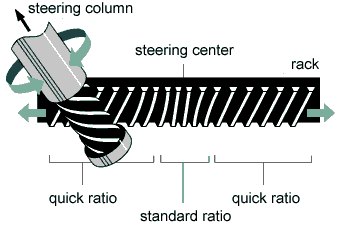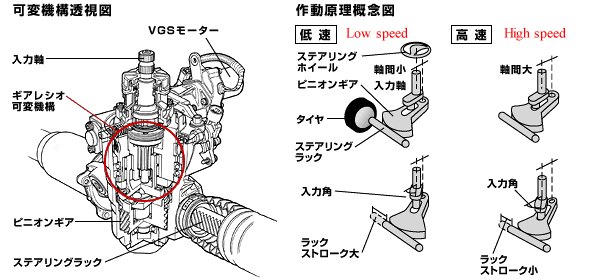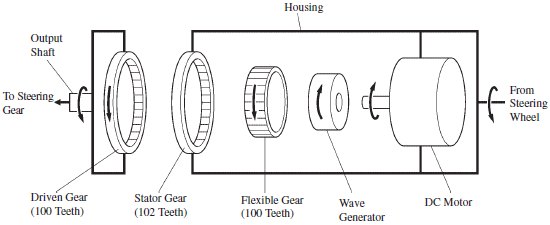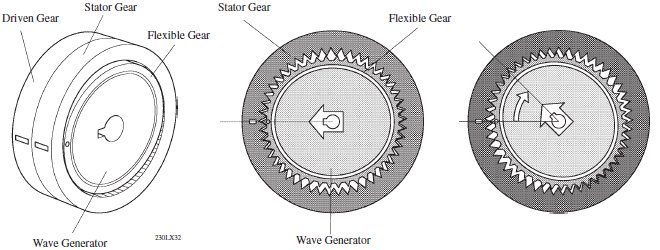|
AUTOZINE TECHNICAL SCHOOL
Steering Variable Gear Ratio Steering
It would be good to have a linear, predictable steering response, but sometimes varying the steering ratio could enhance the driving experience. For example, when cruising on highway we want the steering to be "calmer" to enhance stability and ease of driving, so a slower ratio would be welcomed. In contrast, when turning into a tight corner a quicker steering ratio could speed up the response and reduce driver effort considerably. Variable gear ratio steering is the answer. It is able to vary the steering ratio according to speed and steering angle. In addition to the variable assistance of power steering, you have a fully variable steering. Honda VGR - Honda Accord (1997) Debuted on the Japanese market Accord in 1997, Honda's VGR (Variable Gear Ratio) was claimed to be the world's first electrical power steering featuring variable gear ratio function. As seen in the photo below, this is a simple, pure mechanical design implemented by means of a special steering rack. The teeth on the rack are closer together near the center and farther apart near the sides. This means it reacts slower on the straight ahead and quicker at larger steering angle. BTW, Mercedes uses the same means in its "Direct Steer" option.  Some might say its steering ratio is not truly variable because the gear pattern is already fixed in the rack. It depends on your view point. Yes, the VGR cannot vary ratio according to speed or some other factors, but it does vary according to steering angle, which is most essential to the driver in real-world usage. Since the gear pattern is fixed, its response is fully predictable once the driver get used to it. Honda VGS - Honda S2000 (year 2000) The world's first fully variable ratio steering was also developed by Honda. Called VGS (confusingly, again standards for Variable Gear-ratio Steering), it was introduced to the S2000 sports car in 2000. The system adds a VGS device between the steering shaft and pinion gear to implement the variable ratio function. This device is quite sophisticated (I studied its patent filing on the web and found it difficult to understand), but its simplified principles can be seen in the drawing below. Basically, it deliberately places the input shaft (linked to the steering wheel) and output shaft (linked to the pinion of steering rack) at different axes. The distance between the 2 axes can be varied by an electric motor (not the one of the power steering). As the distance varies, the rotation angle of the output shaft also varies in relation to the input shaft, thus the steering ratio is changed. The ratio is determined by ECU according to speed as well as steering angle. With VGS, the lock-to-lock ratio of S2000 is almost halved to just 1.4 turns, greatly enhancing its response in tight corners.  Toyota VGRS - Toyota Land Cruiser (2002) 2 years after Honda, Toyota launched its own VGRS on its Land Cruiser SUV. It usage was then extended to the luxury cars of Toyota and Lexus. Its mechanism is completely different from Honda's:  The VGRS device contains an electric
motor, a so-called "wave generator" and 3 gears, i.e. a 100-teeth
flexible gear,
a 102-teeth stator gear and a 100-teeth driven gear. The stator gear
and motor are fixed to the
device housing, which is connected to the input shaft. The driven
gear is connected to the output shaft. The flexible gear is an
elastic plastic ring gear. It is inserted inside the stator gear and
driven gear.
 The wave generator is an elliptic
cylinder. Its long axis presses against the flexble gear such that the
teeth of the flexible gear
mesh with both the stator gear and driven gear simultaneously. When
the motor is stationary, the whole assembly rotates together, thus
there is no angle difference between the input shaft and output shaft.
When
the motor drives the wave generator, the mesh area between the gears
rotates as well (see below).
 This rotation couples to the driven gear. Since the driven gear has fewer teeth than the stator gear (100 vs 102), this means when the flexible gear rotates one turn, the driven gear rotates by only 2 teeth in relation to the stator gear. If the motor rotates 50 turns, the driven gear will rotate 1 full turn in relation to the stator gear. If the motor spins at the same direction as the steering action, the steering will speed up (i.e. quicker ratio). If it spins at reverse direction, the steering will slow down (i.e. slower ratio). As the teeth difference is only 2 percent, the adjustment could be very fine. That's why Toyota claims its VGRS works more precisely than rivalling systems. The control strategy of VGRS depends very much on speed and less to steering angle (compared with Honda VGS), but it responds to also the electronic stability control. For example, when the stability control detects tire slip and loss of stability, the VGS will switch to quicker ratio so that the driver will be able to counter steer and save the car immediately. In case of system failure, the lock mechanism on VGRS will lock the gears together. BTW, Audi has been using a similar device called "Dynamic Steering" since 2007. Its working principle is essentially the same as VGRS. I wonder if it needs to pay license fees to Toyota. BMW Active Steering - BMW 5-Series E60 (2003) BMW introduced its first variable ratio steering, Active Steering, on the 5-Series E60 in 2003. It was developed in conjunction with steering expert ZF (more by the latter, I think). Unlike Honda and Toyota's approach, Active Steer was really active... it varied the ratio all the time during cornering, not only depending on speed and steering angle but it also intervened actively to compensate understeer and oversteer. In reality, this made the steering very unpredictable, so it got a poor reputation from the beginning. I think BMW toned it down in later years, but it remained rarely recommended by automotive journlists.  The Active Steering is implemented by a planetary gear set. There are 2 sun gears, one connected to the input shaft (linked to the steerng wheel) and one to the output shaft (linked to the steering rack/pinion). 3 pairs of planetary gears mesh with both sun gears simultaneously. Normally, the planetary gear carrier is stationary, thus all these components rotate together with the input shaft without alteration. There is also an electromagnetic lock to lock them together (it disengages only when energized, so in the event of system failure the steering shafts will be locked together automatically). When variable ratio is needed, the ECU disengages the electromagnetic lock and turns on the electric motor. The motor spins the planetary gear carrier. As a result, drive will go through the planetary gears and superimpose to the output shaft. By altering the speed and rotation direction of motor, it can speed up or slow down the steering output. On the 5-Series E60, the system could vary steering between 5.0 and 1.7 turns lock to lock. |
||
 |
||
| Copyright© 1997-2016 by Mark Wan @ AutoZine |